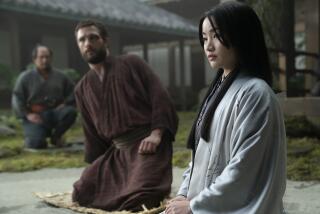Review: History’s ‘The Bible’ an epic, epically overwrought, tale
History channel, which for so many years seemed dedicated primarily to discovering how many documentaries might be extracted from the Second World War — the Hitler Channel was its joking sobriquet — has been branching out. Last year, its “Hatfields & McCoys” miniseries set basic-cable records and was nominated for 16 Emmys (and won five). Sunday brings its first scripted drama, “Vikings,” and another miniseries, “The Bible,” scheduled so that it ends on Easter.
There are millions if not billions who take the Bible as literal truth, but it is not history as we commonly understand the word. There are historical components to the series, of course — decisions have been made about costumes and settings and incidental behavior, and some of the narrative in the New Testament episodes has been lifted from other ancient texts — but the series is ultimately a work of the imagination; indeed, it could have used a little more.
Its creators are Mark Burnett, the man behind “Survivor” and “The Voice” and other monuments of reality television, and his wife Roma Downey, who starred in “Touched By an Angel” (and plays Jesus’ mother, Mary, in her older scenes). They are not in it for the money: “I’ve loved Jesus all my life,” Downey told the Christian Post recently, adding that “Casting began with prayer.”
Theirs is a Christian view, in which the Old Testament is a prophetic prelude to the New. Five of the 10 hours are taken up with Jesus — the last of them, post-crucifixion, follows the fortunes of the apostles — which allows that story more room to breathe The first five are a bit of a greatest-hits package, hurried along by the narration of Keith David, whose voice you know as well as your own, and titles reading “12 years later,” “40 years later” and so on.
Many viewers will be satisfied that TV is telling these stories at all, and not even on a Christian network, though they do make their way pretty regularly to the tube. They are, after all, the most illustrated stories in the West. That the Bible itself does not offer much in the way of description or dialogue leaves a lot of space for elaboration that has kept it adaptable through the ages, the source of works of high and low art over millenniums, from medieval mystery plays to the songs of the Golden Gate Quartet, from small painted icons to huge Gothic cathedrals. But it is the source of much awful kitsch too.
PHOTOS: Best TV Moments of 2012
“The Bible” according to Burnett and Downey is a handsome and generally expensive-looking production, but it is also flat and often tedious, even when it tends to the hysterical, and as hard as the Hans Zimmer soundtrack strains to keep you on the edge of your sofa. The dialogue is pedestrian and functional — sometimes it has the flavor of having been made up on the spot — and often overacted, as if in compensation. It is “psychological” only in obvious ways, with the poetry of the King James version all but ignored.
If Bible stories have been an occasion for slipping a little more sex into the culture than the culture was quite ready for, “The Bible” stays modest on this account. (I have not seen episodes dealing with David and Bathsheba or Samson and Delilah — six of 10 were provided for review — so I may be proved wrong on this account.) You get a bit of the bare shoulder of Hagar, the servant girl Abraham impregnates, anxious to father the nation God has promised him. The sins of Sodom are represented by kissing, dancing and fire-eating.
Violence, on the other hand, gets a good workout — it’s in the book, after all — with all the brutal modern touches. (Squelchy sound effects, slow motion.) In one notable scene, an angel (Asian, for inclusiveness) finishes off a pair of attackers with a two-handed stab out of a martial arts movie. This is for the kids, I guess.
As the episodes depicting Christ’s condemnation and crucifixion were not available, I can’t address their explicitness or what is perhaps the central interpretive question of such a film — the degree to which whether it blames Pilate or “the Jews” for the death of Jesus. I certainly wouldn’t call the film anti-Semitic, yet it does play to mainstream Western images of Christ:, the postcard, gentile Jesus, depicted as a tall, good-looking European, while his opponents ... aren’t.
He is played here by Diogo Morgado, who is Portuguese, with a smile that practically defines the word “beatific.” And then the trouble starts.
--------------------------
‘The Bible’
Where: History
When: 8 p.m. Sunday
Rating: TV-14-V (may be unsuitable for children under the age of 14 with an advisory for violence)
PHOTOS, VIDEOS & MORE:
PHOTOS: Behind the scenes of ‘Downton Abbey’
VIDEO: Winter TV preview
PHOTOS: Violence in TV shows
More to Read
The complete guide to home viewing
Get Screen Gab for everything about the TV shows and streaming movies everyone’s talking about.
You may occasionally receive promotional content from the Los Angeles Times.






